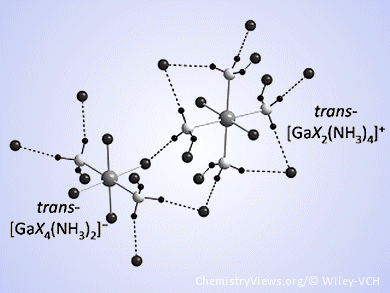Ammonothermal Growth of Gallium Nitride
Gallium nitride (GaN) is an important material for the semiconductor industry. It features a wide band gap and high thermal conductivity at room temperature, which make it a good material for optoelectronic devices and high-performance radio-frequency microdevices. In the European Journal of Inorganic Chemistry, Rainer Niewa and co-workers at the University of Stuttgart and Ludwig Maximilians University of Munich, Germany, report the existence of ammoniates of gallium halides in the ammonothermal growth of GaN and provide a rigorous characterization of these compounds.
Information on Predominant Gallium-Containing Ionic Species
High-quality GaN single crystals are difficult to obtain. The ammonothermal growth technology, which is analogous to the hydrothermal method but uses supercritical ammonia instead of water, is a promising method to grow the best quality GaN crystals. To obtain soluble Ga species, typically ammonium halides or alkali metal amides are added to the reaction mixture. However, the chemistry involved in the crystal growth process is not well understood. Rainer Niewa et al. provide the first comprehensive information on the gallium-containing ionic species likely to predominate in the reaction mixtures used to prepare GaN by using ammonium halides as additive. They elucidate the crystal structures of ammoniates of gallium halides that are highly soluble in supercritical ammonia.
Knowing the solid-state structures of these species, the number of coordinated ammonia and halide ligands, and the conditions under which these compounds form and decompose is a great aid in predicting the mechanisms of the ammonothermal growth of GaN crystals.
- Intermediates in Ammonothermal GaN Crystal Growth under Ammonoacidic Conditions,
Shiyu Zhang, Frauke Hintze, Wolfgang Schnick, Rainer Niewa,
Eur. J. Inorg. Chem. 2013, 31, 5387–5399.
DOI: 10.1002/ejic.201300958




